NCERT Solutions are helpful books for students preparing for the CBSE Class 12 Business Studies examinations. These Solutions of NCERT are crafted by subject matter experts to make learning easy and help students grasp the concepts effortlessly.
Download the PDF of NCERT Solutions for Class 12 Business Studies Chapter 5 – Organising
Access NCERT Solutions for Class 12 Business Studies Chapter 5
Very Short Answer Questions NCERT Business Studies Solutions Class 12 Chapter 5
1. Identify the network of social relationships which arises spontaneously due to interaction at work.
Informal organisation is referred to as the social relationship network that arises naturally as a result of interaction at work. The emergence of an informal organisation is a from social interaction and free flow of communication between the employees of the organisation.
2. What does the term ‘span of management’ refer to?
The term span of management refers to the number of subordinates a manager is able to handle efficiently. It determines the nature and structure of an organisation. There are two types of span of management: 1) Narrow 2) Wide
The span of management is dependent on various factors such as leadership, control, decentralisation extent in the organisation, nature of work and the working ability of the subordinates.
3. State any two circumstances under which the functional structure will prove to be an appropriate choice?
The functional structure requires grouping and organising activities that are of similar nature. Under a functional organisation, each group functions separately and specialises in its work. a financial structure is suitable for organisations that are large and which have various functions.
Here are two circumstances that under functional structure is appropriate. They are
1. Large-sized organisations need to have a functional structure in order to operate smoothly. There will be many departments within the organisation, and making differentiation based on departments is very much helpful for an organisation. It helps in improving the efficiency of the managers so that the work progresses smoothly.
2. A high degree of coordination is required for managing various functions. It is done to improve efficiency. If an organisation has a clear division of work, a functional structure helps in promoting coordination between the various departments and thereby ensures all functions go on smoothly.
4. Draw a diagram depicting a functional structure.

5. A company has its registered office in Delhi, a manufacturing unit in Gurgaon and a marketing and sales department in Faridabad. The company manufactures consumer products. Which type of organisational structure should it adopt to achieve its target?
For this company, the type of organisation structure that needs to be followed is functional organisation. This can be justified using the following points:
1. Being a large organisation, it requires proper departmentalisation. It helps in increasing the efficiency of the managers and also provides a great degree of control over the activities of the organisation.
2. Organisation like this is managing multiple functions simultaneously where coordination of a high degree is required. It can be achieved in a smooth way by arranging a proper division of activities among various departments under a functional structure.
3. Specialisation will be promoted under functional structure, and it will help in performing all the diverse functions effortlessly.
Short Answer Questions NCERT Business Studies Solutions Class 12 Chapter 5
1. What are the steps in the process of organising?
The following steps are involved in the process of organising:
1. The first step that is involved in organising is identifying the number of activities and accordingly dividing them as per the plan. Actions are taken as per the defined objectives. Having a clear division of work keeps duplicity at bay.
2. Actions that were fixed earlier are now arranged in groups based on similarity. This ensures that the department specialising in the work has access to it.
3. The next step in organising is assigning the roles and responsibilities to the person best suited for the job. Work is allocated as per the skills of the members.
4. The next part of organising is the presence of a hierarchy in an organisation. It is very helpful when a person is aware of his immediate superior. A defined organisation structure helps in ensuring the successful functioning of the activities of the organisation.
2. Discuss the elements of delegation.
Delegation is the process of transferring authority and responsibility to subordinates in an organisation. The following are the elements of an organisation:
1. Delegation provides an individual with the power to direct or command a subordinate. This enables them to make decisions regarding what needs to be done and who will be doing that. The chain of command starts from the top level of management and ends at the lower level of management. As authority is delegated, it helps in maintaining discipline and obedience.
2. Responsibility is the part where the subordinate has to adhere to the given task. The duty provided should be performed by the subordinate properly. The responsibility of a subordinate is towards their superior.
3. The superior must be accountable for the outcome of the work that has been assigned by them to their subordinate. The superior should keep track of the work done by the subordinate and must see that it is done satisfactorily.
3. How does an informal organisation support the formal organisation?
The network of relations that is created from the social interactions taking place outside of the office is called an informal organisation. It traces its origin from formal organisations and is not created at will by management. These relationships are built on friendship that develops between co-workers. It supports formal organisations in the following ways:
1. A free flow of communication is established in an informal organisation which leads to communication channels outside the organisation. In this way, communication spreads easily and assists the formal organisation.
2. In informal organisations, people develop good bonding among themselves and thus towards the organisation. It helps in increasing coordination among the members and also promotes mutual trust and respect. The result of such bonding is it lowers the level of conflict.
3. Informal organisations help in fulfilling organisational objectives. Managers can get to know about the workers’ issues and ask for suggestions on improving the work conditions. Happy workers will be more contributing towards an organisation.
4. It helps in building a harmonious work environment by encouraging cooperation among workers and managers. A peaceful work environment is more productive.
5. An informal organisation helps in increasing efficiency among the workers. The workers understand their importance and actively contribute towards organisational growth.
4. Can a large-sized organisation be totally centralised or decentralised? Give your opinion.
Any organisation, regardless of its size, will find it difficult to function properly, either as centralised or decentralised, because there needs to be a balance between the two systems in order to make the best possible utilisation.
In centralisation, the decision-making capacity or authority is restricted to the people sitting at the top level of management. All the decisions regarding the organisation are taken by the top-level management. In stark contrast to this system, decentralisation works by delegating the decision-making capacity to the managers at a lower level. There is a distribution of decision-making capabilities which is spread evenly.
For an organisation to perform at its best, it has to follow a mix of centralisation and decentralisation. A growing organisation cannot rely on centralisation to manage all the functions. It would slow down the decision-making process for the organisation. Hence, a decentralised system helps ease the load on decision-making. Also, an organisation cannot let all the decisions be made by the lower level management, as it will be a risk to the integrity of the organisation.
Therefore, there should be a balance between centralisation and decentralisation in an organisation.
5. Decentralisation is extending delegation to the lowest level. Comment.
Decentralisation and delegation are similar in nature. Both are about transferring responsibility and authority. In the case of delegation, authority is shared among two individuals, i.e., superior delegating authority to subordinate, whereas in decentralisation, the authority is shared at multiple levels. Therefore, it can be said that the act of delegating authority at each level of management promotes decentralisation, while the act of decentralisation helps promote delegation at the lowest level.
6. Neha runs a factory wherein she manufactures shoes. The business has been doing well, and she intends to expand by diversifying into leather bags as well as western formal wear, thereby making her company a complete provider of corporate wear. This will enable her to market her business unit as the one-stop for working women. Which type of structure would you recommend for her expanded organisation and why?
The organisation structure that Neha can follow is the divisional organisation structure. Under this system, there will be separate departments which will take care of different products. There will be separate personnel for managing the departments.
The divisional structure is recommended for the following reasons:
1. Each department will have a head, who will be accountable for the overall performance of the department. The performance of individual departments can be determined easily; the best and worst performers can be identified, and necessary steps can be taken.
2. Decision-making will be quick as each department has a specialist to manage it.
3. Having a divisional structure allows for adding more divisions without impacting the functions of the organisation.
7. The production manager asked the foreman to achieve a target production of 200 units per day, but he didn’t give him the authority to requisition tools and materials from the store’s department. Can the production manager blame the foreman if he is not able to achieve the desired target? Give reasons.
No, in this case, the production manager cannot blame the foreman as he was provided with responsibility, but he was not given authority. With responsibility, there should be an authority also, which is essential for a task to complete.
Long Answer Questions NCERT Business Studies Solutions Class 12 Chapter 5
1. Why delegation is considered essential for effective organising?
Delegation is the transfer of authority from a superior to a subordinate. It helps in reducing the workload on the manager so that manager can give focus on areas that need more attention. It also provides subordinates to become more responsible and makes way for more growth opportunities.
The following points show the importance of delegation, which is effective in organising:
1. By delegating work to the subordinate, the managers can focus on other areas, which improves the efficiency of managers.
2. Employees also get the chance to perform well and improve their skills. It helps in developing the skillset of the employees.
3. The act of delegation gives employees responsibility, and it also provides motivation to the employees, as they feel that they belong to the organisation and their contributions are recognised.
4. Delegation helps in the career development of many managers as they take up more roles in the organisation. It also helps workers to gain more experience, which helps in career growth.
5. It helps in forming an organised structure in the organisation. The lines of the hierarchy are well-defined, which makes processes smooth.
6. It increases coordination among managers and workers. There is a well-defined working relationship, which makes things more organised in the company.
2. What is a divisional structure? Discuss its advantages and limitations.
Divisional structure is a system where work is divided into different departments. There is a separate head for each department, and there is no overlapping of responsibilities in such a structure. The field of work is clearly defined.
Here are some of the advantages of a divisional structure.
1. Managers and workers get ample opportunity to grow in their departments and become specialists in the product. It is helpful in increasing the efficiency of the workforce.
2. Each division or department can be tracked individually for their performance. It leads to the identification of the best and worst-performing divisions.
3. The divisions are independent to take their own decisions, which makes the decision-making process quick. Rapid decision-making enables faster implementation, which is beneficial for the organisation.
4. Having a divisional structure allows for adding more divisions without impacting the functions of the organisation.
The disadvantages can be highlighted as
1. There can be conflicts among departments with regard to the allocation of funds and resources.
2. There can be a rise in cost due to duplication of work among departments. There might be some activities that are common across all departments, and employing separate personnel for each department for these activities can drive the cost higher.
3. There can be a chance that due to more focus on improving the individual departments, the growth of the organisation as a whole can get hampered.
3. Decentralisation is an optional policy. Explain why an organisation would choose to be decentralised.
Decentralisation is the delegation of authority among various levels in an organisation ranging from the top level to the lower level. It is not mandatory for an organisation to follow decentralisation, but it is beneficial in the long run. Here are a few points that will support the statement of why an organisation wants to be decentralised.
1. Decentralisation allows lower-level managers to be independent in making their decisions. It gives more confidence and a feeling of responsibility to the managers.
2. Decentralisation provides the managers with an opportunity to grow and be a part of the growth of the organisation. It helps in skill development and the ability to tackle new challenges. It also provides a platform to showcase their talent and get noticed for more responsible positions.
3. Decentralisation helps analyse the performance of every department and also determine how each one of them is helping the organisation in fulfilling its objectives.
4. Decision-making is faster in a decentralised organisation. There is no need to take approval from the top-level to perform basic-level functions, it helps to avoid delays in decision-making.
5. The decentralisation system offers growth opportunities for managers at lower levels. There is a tendency to outperform each other, which results in more productivity and indirectly leads to the growth of the individuals.
6. Decentralisation makes work load of top-level management less. They can concentrate more on policy-making for organisation growth.
4. Distinguish between centralisation and decentralisation.
The points of difference between centralisation and decentralisation are as follows:
| Basis of Comparison | Centralisation | Decentralisation |
| Authority | Authority rests with the top management. | Authority delegated across multiple levels, |
| Flow of Information | Open and free. | It’s vertical. |
| Work Load | Top-level managers have a higher workload. | Workload is less as work is divided between levels. |
| Scope of Delegation | Limited scope of delegation. | Wide scope of delegation. |
| Subordinate Initiative | Initiatives by subordinates have a limited scope, as they need to follow a pre-decided path as laid out by superiors. | Subordinates are encouraged to be more proactive and take the initiative. It allows more freedom to express ideas for improving the organisation. |
| Decision Making | Decision-making is slow and leads to inefficiency | Quick decision-making as decision-making authority is delegated across levels. |
5. How is a functional structure different from a divisional structure?
The points of difference between functional structure and divisional structure are as follows:
| Basis of Comparison | Functional structure | Divisional structure |
| Creation | Functional structures are created on the basis of functions in an organisation. | Divisional structures are created on the basis of products as well as functions. |
| Costs | By minimising duplication of work, it becomes economical. | Duplication of work is more as the same work is done between various departments. |
| Decision Making | Centralised decision-making, as decisions are made by the head of respective departments. | Decentralised decision-making, as there is a separate decision-making authority for each product. |
| Overlapping of work | Minimised as separate functional departments are there. | Increased, as each department has the same levels of work. |
| Suitability | Companies focusing on operational specialisation will find this structure more feasible. | Suitable for companies focusing on creating differentiated products. |
| Functional Hierarchy | Arranging departments on the basis of important operations leads to the formation of a horizontal functional hierarchy. | When departments are arranged on the basis of product lines, it results in the formation of a vertical functional hierarchy. |
6. A company, which manufactures a popular brand of toys, has been enjoying a good market reputation. It has a functional organisational structure with separate departments for Production, Marketing, Finance, Human Resources and Research and Development.
Lately, to use its brand name and also to cash on new business opportunities, it is thinking of diversifying into the manufacture of a new range of electronic toys for which a new market is emerging. Which organisation structure should be adopted in this situation? Give concrete reasons with regard to benefits the company will derive from the steps it should take.
The company should adopt a divisional organisation structure, as it is the ideal structure for this organisation.
Following are the benefits that can be obtained by following this structure:
1. Each department will have a head who will be accountable for the overall performance of the department. The performance of individual departments can be determined easily; the best and worst performers can be identified, and necessary steps can be taken.
2. Decision-making will be quick, as each department has a specialist to manage it.
3. Having a divisional structure allows for adding more divisions without impacting the functions of the organisation.
7. A company manufacturing sewing machines set up in 1945 by the British promoters follows formal organisation culture in totality. It is facing a lot of problems with delays in decision-making. As a result, it is not able to adapt to changing business environment. The workforce is also not motivated since they cannot vent their grievances except through formal channels, which involve red tape. Employee turnover is high. Its market share is also declining due to changed circumstances and the business environment. You are to advise the company with regard to change it should bring about in its organisation structure to overcome the problems faced by it. Give reasons in terms of benefits it will derive from the changes suggested by you.
The change that can be suggested in this situation is adopting some space for informal structure by making changes in its current formal organisation structure.
An informal structure would offer the following benefits:
1. Information will move faster, as there is no definite channel of communication that needs to be followed.
2. It will offer a sense of belongingness to the employees as the rules of communication are beyond official roles. Employees feel more secure in the organisation and work towards the betterment of the organisation.
3. It supports the working of a formal organisation, as it helps in fulfilling the organisational objectives in a manner beneficial for the organisation.
4. The company can also diversify their product range by venturing into sewing products, such as producing machinery with embroidery features.
8. Company X limited manufacturing cosmetics, which has enjoyed a pre-eminent position in business, has grown in size. Its business was very good till 1991. But after that, a new liberalised environment has seen the entry of many MNCs in the sector. As A result, the market share of X limited has declined. The company had followed a very centralised business model with Directors and divisional heads making even minor decisions. Before 1991, this business model had served the company very well, as consumers had no choice. But now the company is under pressure to reform.
Questions
What organisation structure changes should the company bring about in order to retain its market share?
How will the changes suggested by you help the firm? Keep in mind that the sector in which the company is FMCG.
The major change that needs to be adopted by the organisation is a move towards decentralisation. The organisation is growing and centralisation will not be sufficient for the organisation. The employees must be provided with more responsibility and authority, which ensures the proper functioning of the organisation.
Decentralisation also enables faster decision-making within the organisation.
The benefits of decentralisation will benefit the organisation in the following ways:
1. Lower-level managers will have the freedom to make their own decisions, which improves the efficiency of the work done.
2. It helps in developing the skills of the managers and also results in providing more growth opportunities for the managers.
3. Decisions taken by management are quick and timely. It helps in finding the solutions to problems easily.
NCERT Solution for Class 12 Business Studies Chapter 5 – Organising provides us with a brief introduction to the concepts. It provides a clear picture of the next step of planning, i.e., organising.
- Meaning and process of organising
- Importance of organising
- Organisational structure
- Types of organisational structure
Conclusion
NCERT Solutions for Class 12 Business Studies Chapter 5 provides a broad degree of illustrative examples, which helps the students to comprehend and learn quickly. The above-mentioned are the illustrations for the Class 12 CBSE syllabus. For more solutions and study materials of NCERT solutions for Class 12 Business Studies, visit BYJU’S or download the app for the best learning experience.
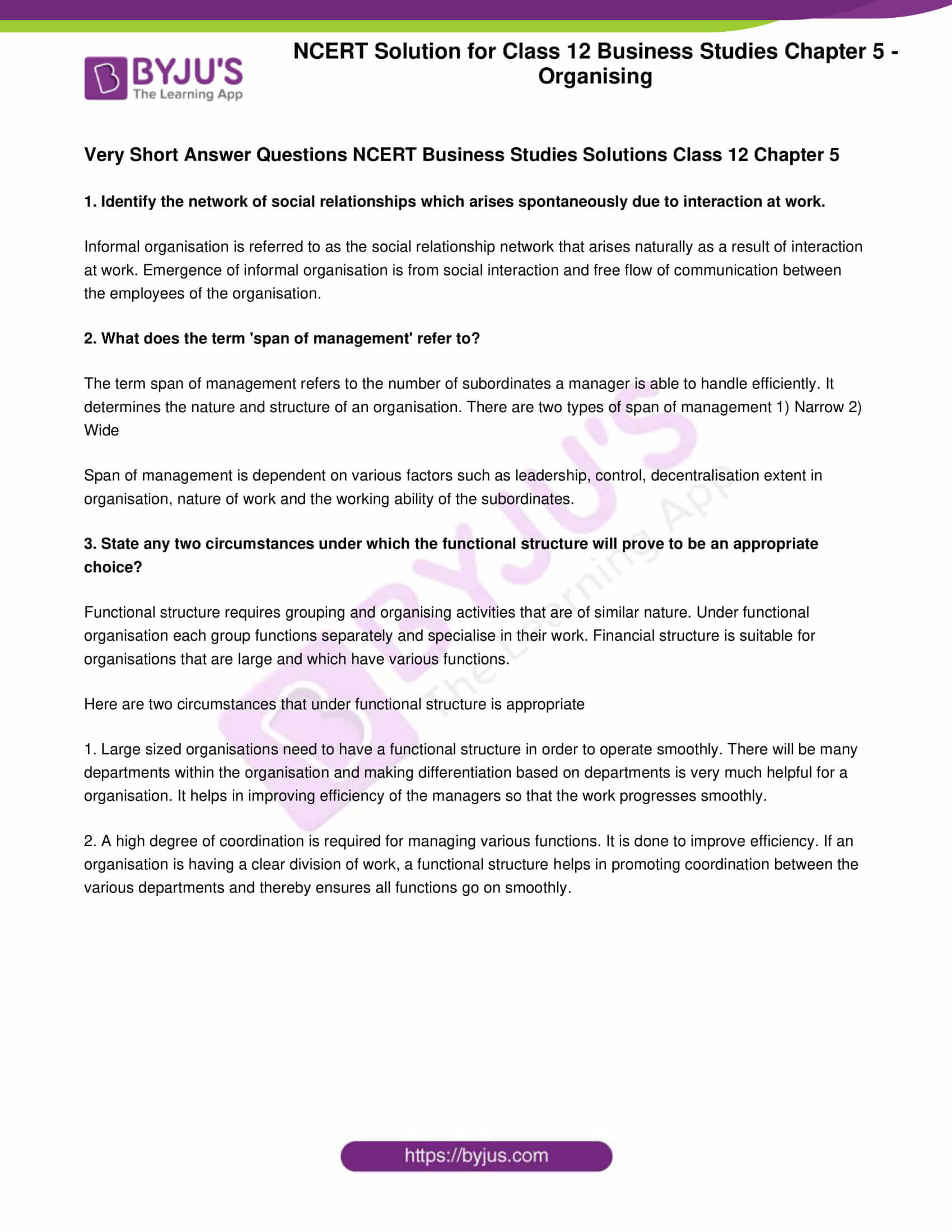
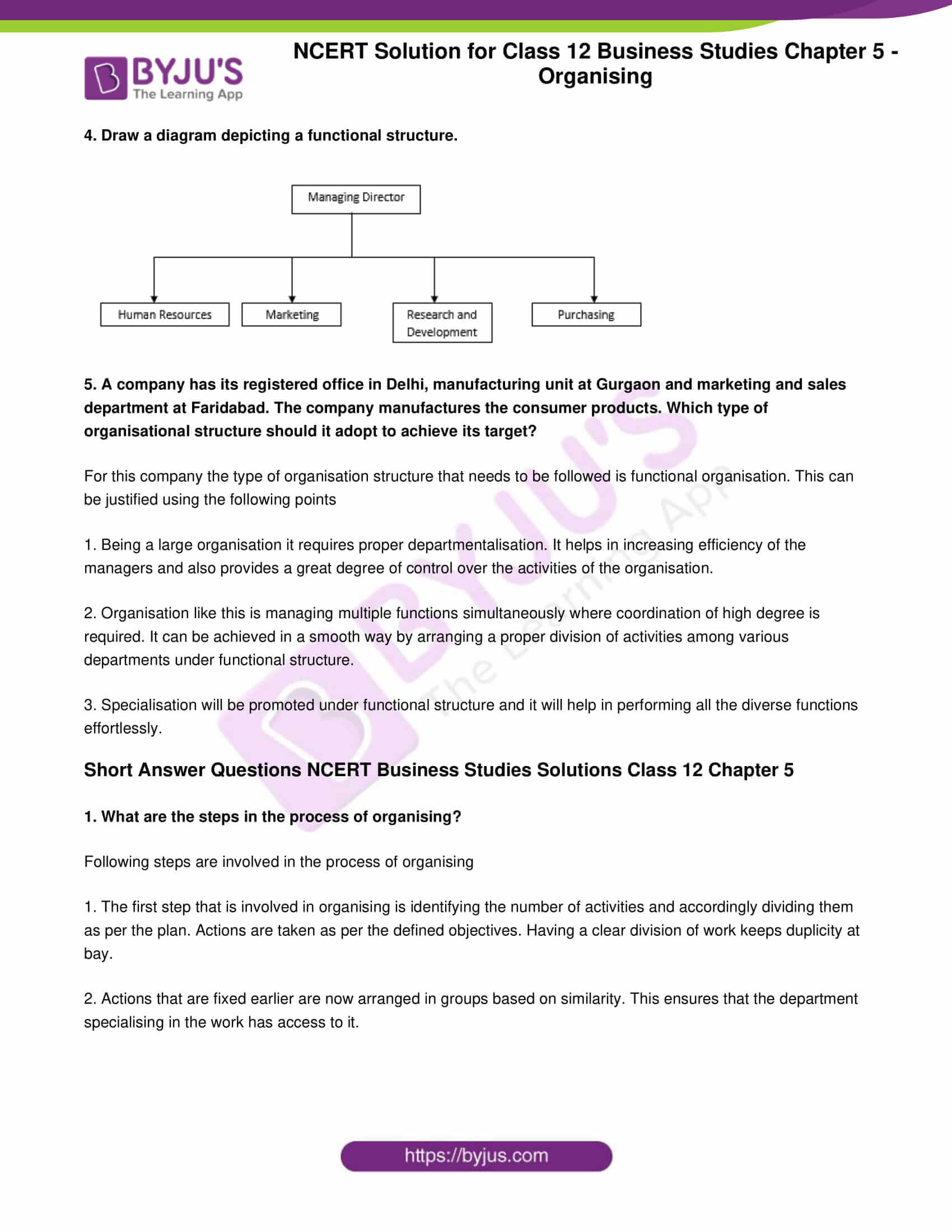

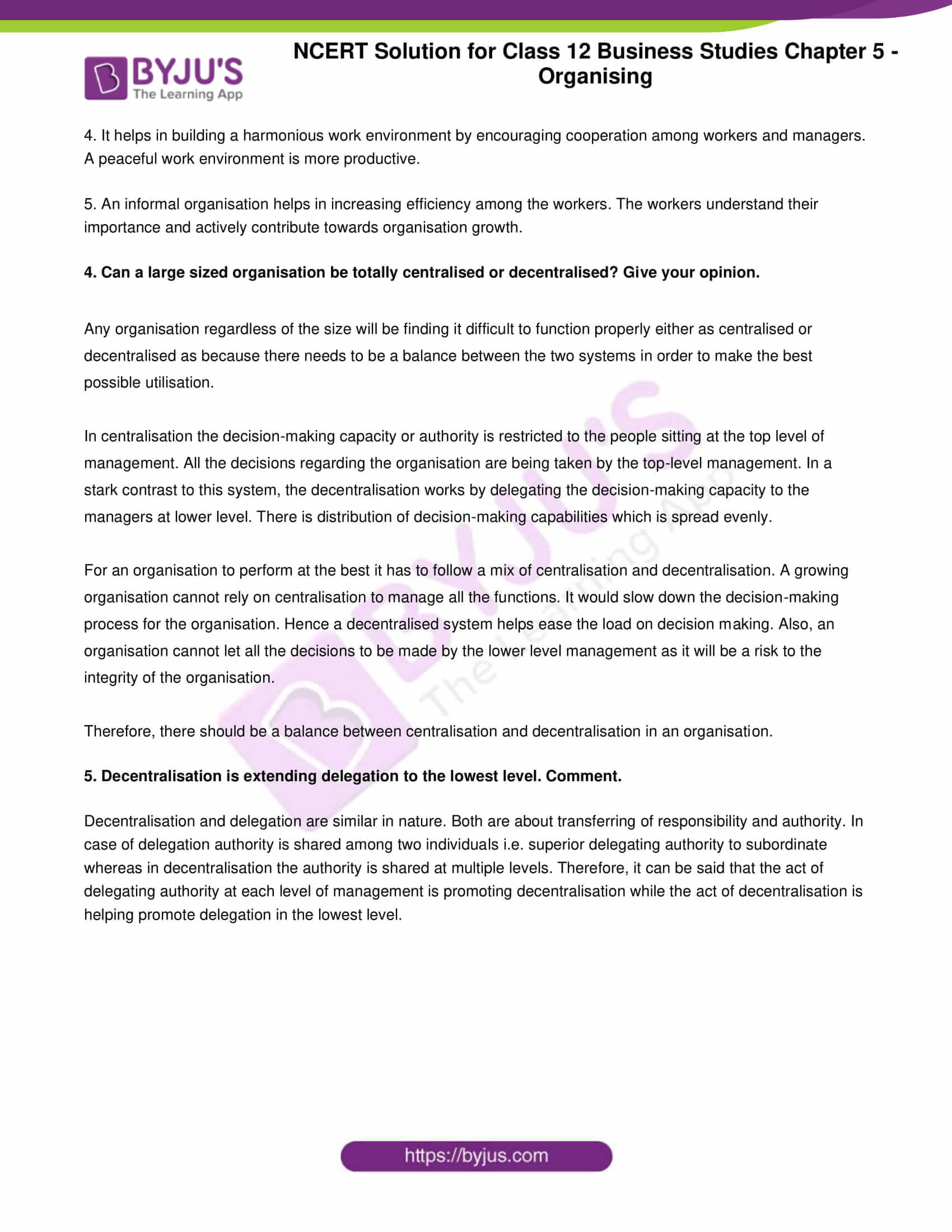

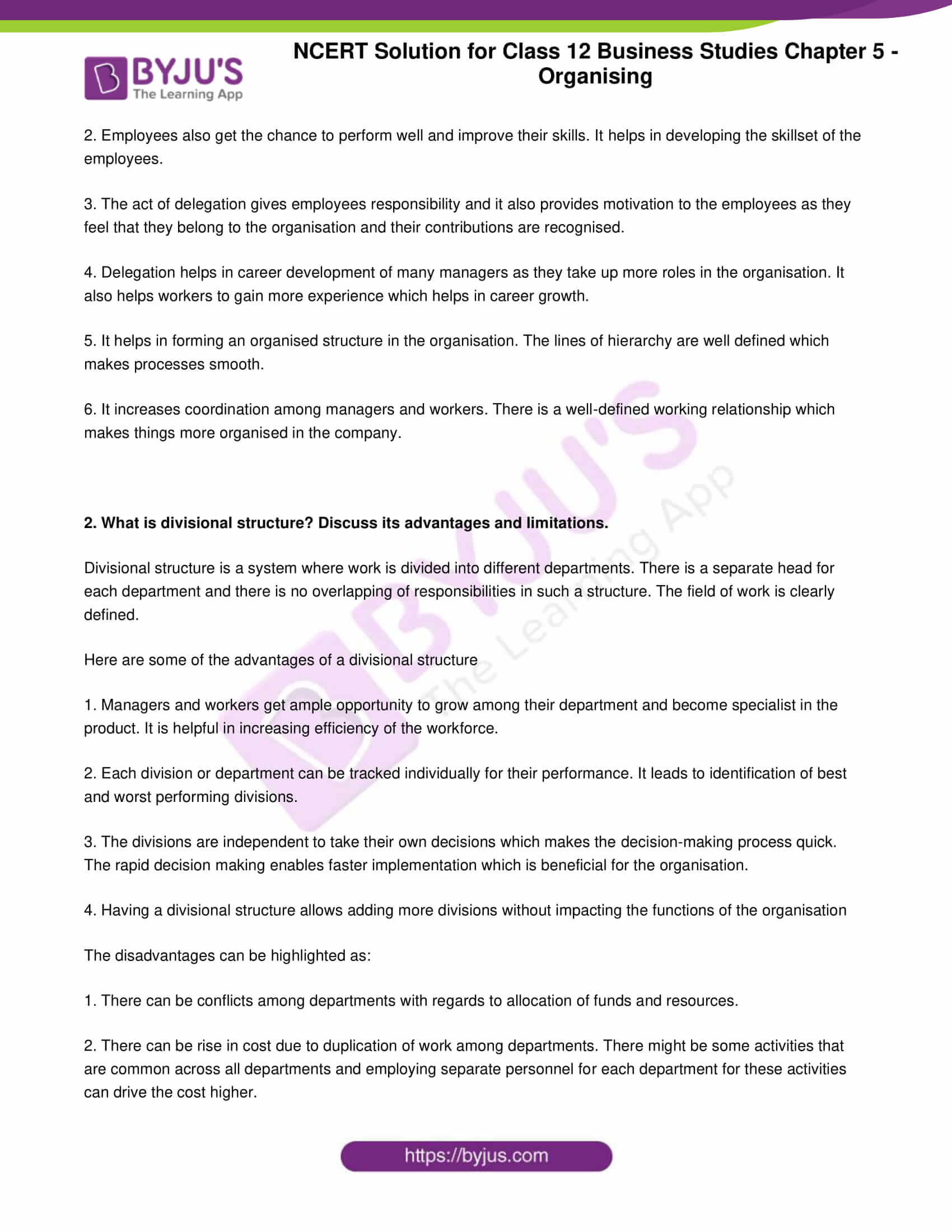
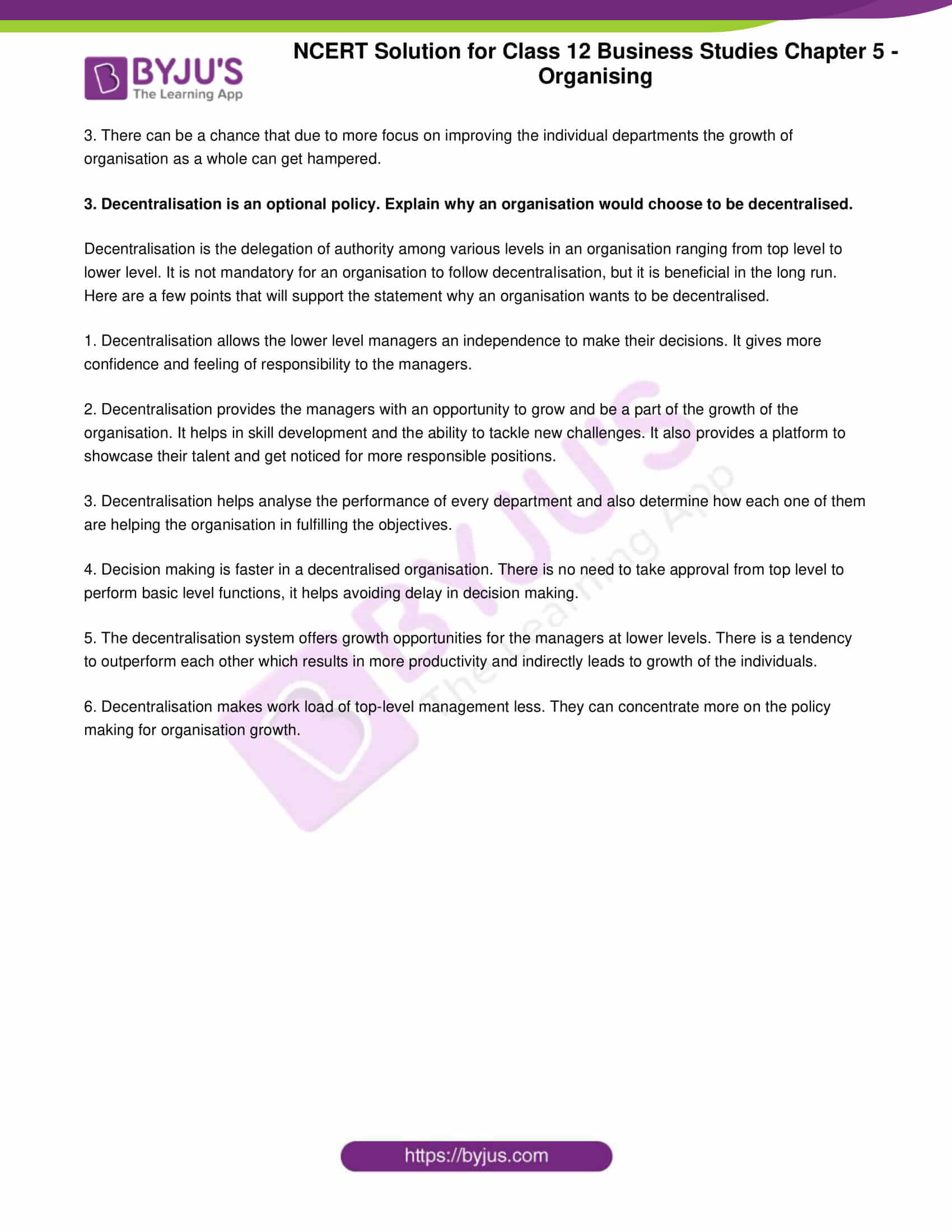

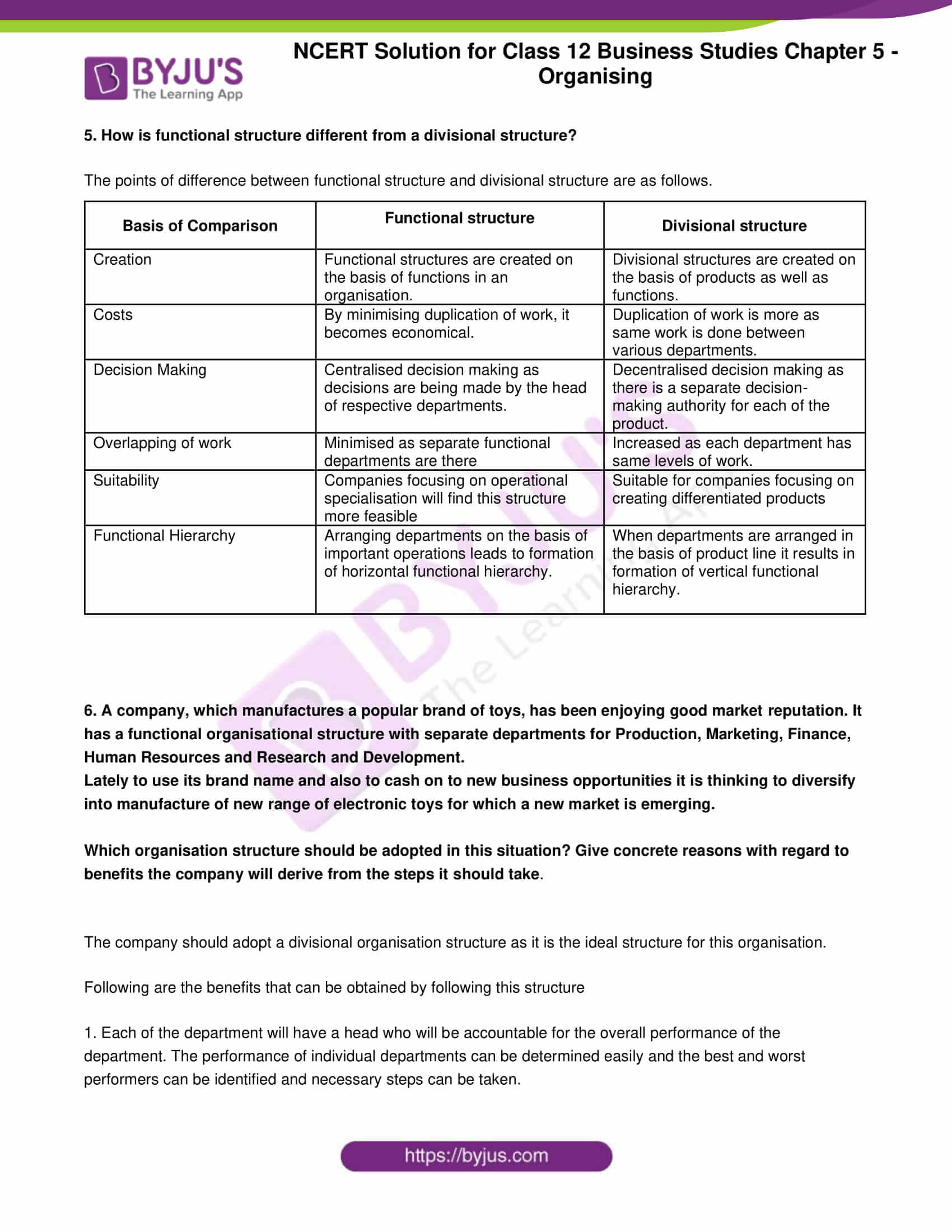
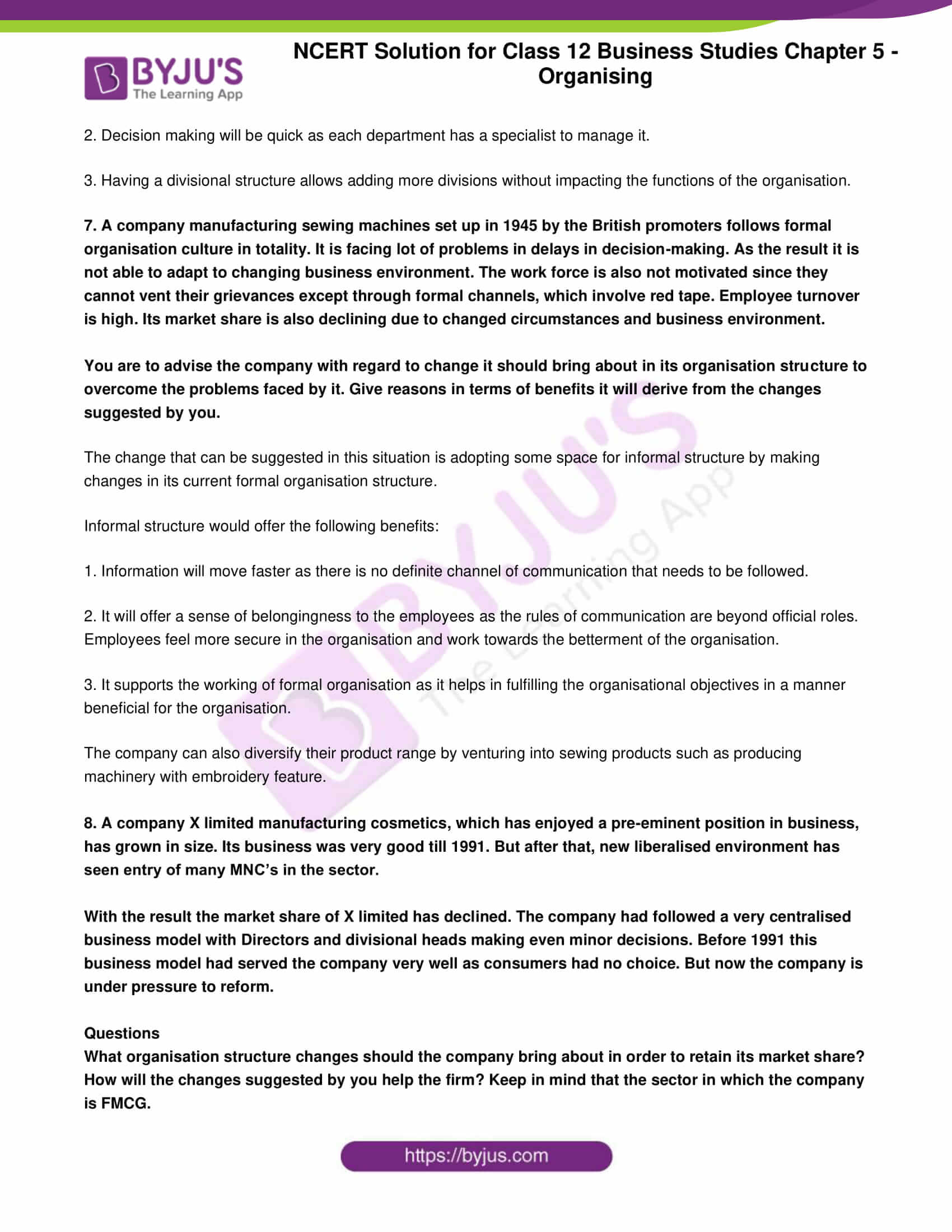

Comments